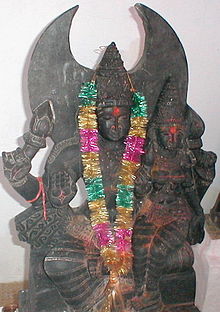Chandra
This article has multiple issues. Please help improve it or discuss these issues on the talk page. (Learn how and when to remove these template messages)
|
| Chandra | |
|---|---|
The Moon God of Night, Plants and Vegetation | |
| Devanagari | चन्द्र |
| Abode | Moon |
| Day | Monday |
In Hinduism, Chandra (Sanskrit: चन्द्र, IAST: Candra, lit. "shining")[1][a] is a lunar god and a Graha. Chandra is synonymous with Soma. The Chandra is the lord of plants and vegetation.
Chandra is described as young, beautiful; two-armed and having in his hands a club and a lotus.[2] He rides his chariot across the sky every night, pulled by ten white horses or an antelope.[citation needed]
In Hindu mythology, Chandra is the father of Budha (planet Mercury). He is married to 27 daughters of Daksha, after whom the Nakshatras in Hindu astrology are named.
Mythology

In Hindu mythology, there are many versions of legends around Chandra's family. In one, he meets Tara, the wife of Brihaspati (planet Jupiter). From their union, Tara became pregnant giving birth to Budha (planet mercury). Brihaspati becomes upset and declares a war. The Devas intervene, and Tara returns to Brihaspati.[3] In another, Chandra marries the twenty-seven daughters of Daksha. The Moon favors Rohini – one of his wives, the others become upset and complain to Daksha. He places a curse on the moon, which he then overcomes by devoting himself to Shiva, who partially releases him from the curse, and this partial release accounts for the Moon's waxing and waning, according to the legend.[3]
Dark spot on the Moon
One popular story to account for the dark spot on the Moon is that Ganesha, once filled with food, fell from his mouse and broke his stomach. Chandra laughed at this, for which Ganesha injured him by breaking off and throwing away one of his tusks; and cursed him so that it would be forbidden to behold Chandra on Ganesh Chaturthi.[citation needed]
Other aspects
Chandra is also the word in Sanskrit, Hindi and other Indian languages for the Moon. It is also a common Indian name, both male and female and exists as a name in many South East Asian languages that originate from Sanskrit.
Indu, one of the other names for Chandra, is also the name of the first chakra of Melakarta ragas in Carnatic music. The names of chakras are based on the numbers associated with each name. In this case, there is one, the Moon and hence the first chakra is Indu.[4][5]
In popular culture
Chandra plays an important role in one of the first novel-length mystery stories in English, The Moonstone.
The Sanskrit word Chandrayāna (Sanskrit: चन्द्रयान, Moon Vehicle) is used to refer to India's lunar orbiters.
See also
Notes
- ^ In other languages: Kannada ಚಂದ್ರ, Telugu చంద్రుడు, Tamil சந்திரன்.
References
- ^ Graha Sutras By Ernst Wilhelm , Published by Kala Occult Publishers ISBN 0-9709636-4-5 p.51
- ^ Mythology of the Hindus By Charles Coleman p.131
- ^ a b Roshen Dalal (2010). Hinduism: An Alphabetical Guide. Penguin Books India. pp. 393–394. ISBN 978-0-14-341421-6.
- ^ South Indian Music Book III, by Prof. P Sambamoorthy, Published 1973, The Indian Music Publishing House
- ^ Ragas in Carnatic music by Dr. S. Bhagyalekshmy, Pub. 1990, CBH Publications
External links
 Media related to Chandra at Wikimedia Commons
Media related to Chandra at Wikimedia Commons

